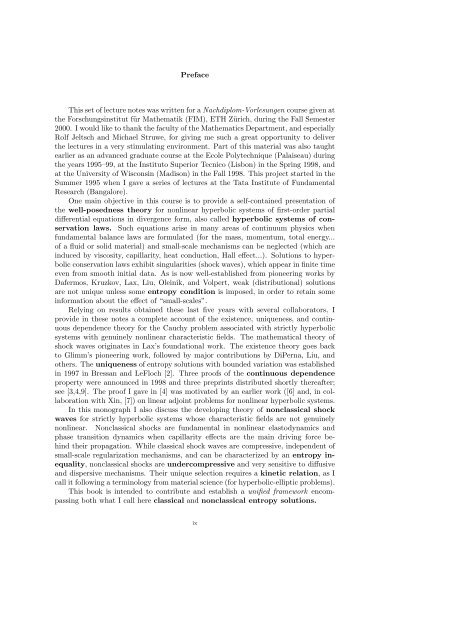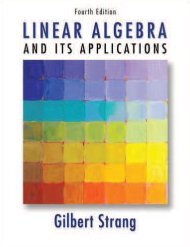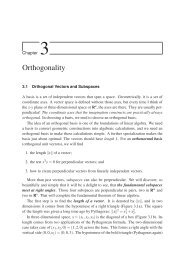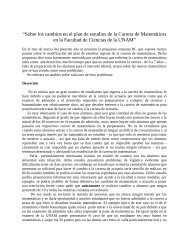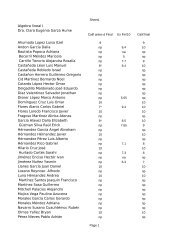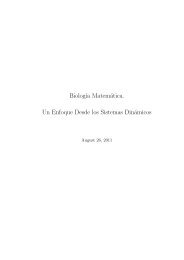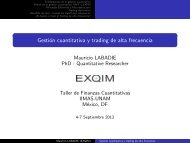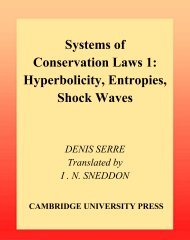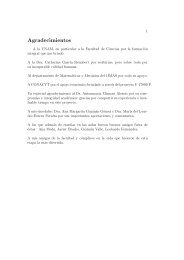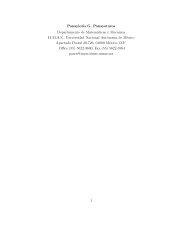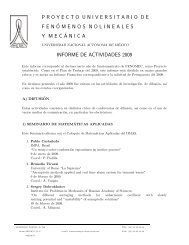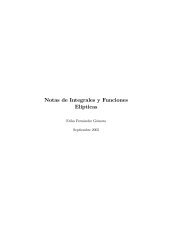Order Form - FENOMEC
Order Form - FENOMEC
Order Form - FENOMEC
You also want an ePaper? Increase the reach of your titles
YUMPU automatically turns print PDFs into web optimized ePapers that Google loves.
Preface<br />
This set of lecture notes was written for a Nachdiplom-Vorlesungen course given at<br />
the Forschungsinstitut für Mathematik (FIM), ETH Zürich, during the Fall Semester<br />
2000. I would like to thank the faculty of the Mathematics Department, and especially<br />
Rolf Jeltsch and Michael Struwe, for giving me such a great opportunity to deliver<br />
the lectures in a very stimulating environment. Part of this material was also taught<br />
earlier as an advanced graduate course at the Ecole Polytechnique (Palaiseau) during<br />
the years 1995–99, at the Instituto Superior Tecnico (Lisbon) in the Spring 1998, and<br />
at the University of Wisconsin (Madison) in the Fall 1998. This project started in the<br />
Summer 1995 when I gave a series of lectures at the Tata Institute of Fundamental<br />
Research (Bangalore).<br />
One main objective in this course is to provide a self-contained presentation of<br />
the well-posedness theory for nonlinear hyperbolic systems of first-order partial<br />
differential equations in divergence form, also called hyperbolic systems of conservation<br />
laws. Such equations arise in many areas of continuum physics when<br />
fundamental balance laws are formulated (for the mass, momentum, total energy...<br />
of a fluid or solid material) and small-scale mechanisms can be neglected (which are<br />
induced by viscosity, capillarity, heat conduction, Hall effect...). Solutions to hyperbolic<br />
conservation laws exhibit singularities (shock waves), which appear in finite time<br />
even from smooth initial data. As is now well-established from pioneering works by<br />
Dafermos, Kruzkov, Lax, Liu, Oleinik, and Volpert, weak (distributional) solutions<br />
are not unique unless some entropy condition is imposed, in order to retain some<br />
information about the effect of “small-scales”.<br />
Relying on results obtained these last five years with several collaborators, I<br />
provide in these notes a complete account of the existence, uniqueness, and continuous<br />
dependence theory for the Cauchy problem associated with strictly hyperbolic<br />
systems with genuinely nonlinear characteristic fields. The mathematical theory of<br />
shock waves originates in Lax’s foundational work. The existence theory goes back<br />
to Glimm’s pioneering work, followed by major contributions by DiPerna, Liu, and<br />
others. The uniqueness of entropy solutions with bounded variation was established<br />
in 1997 in Bressan and LeFloch [2]. Three proofs of the continuous dependence<br />
property were announced in 1998 and three preprints distributed shortly thereafter;<br />
see [3,4,9]. The proof I gave in [4] was motivated by an earlier work ([6] and, in collaboration<br />
with Xin, [7]) on linear adjoint problems for nonlinear hyperbolic systems.<br />
In this monograph I also discuss the developing theory of nonclassical shock<br />
waves for strictly hyperbolic systems whose characteristic fields are not genuinely<br />
nonlinear. Nonclassical shocks are fundamental in nonlinear elastodynamics and<br />
phase transition dynamics when capillarity effects are the main driving force behind<br />
their propagation. While classical shock waves are compressive, independent of<br />
small-scale regularization mechanisms, and can be characterized by an entropy inequality,<br />
nonclassical shocks are undercompressive and very sensitive to diffusive<br />
and dispersive mechanisms. Their unique selection requires a kinetic relation, asI<br />
call it following a terminology from material science (for hyperbolic-elliptic problems).<br />
This book is intended to contribute and establish a unified framework encompassing<br />
both what I call here classical and nonclassical entropy solutions.<br />
ix


